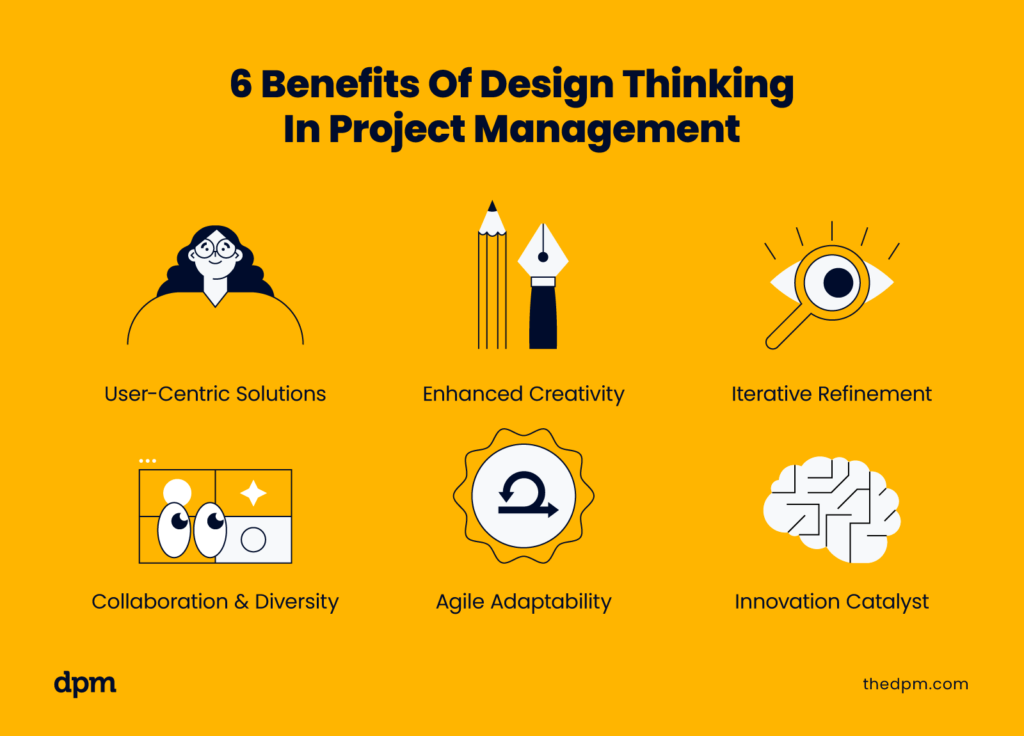Solving ill-defined and complex problems is a common piece of projects and project management. When a project’s output is intended to be unique, and whose success depends heavily on the end user’s acceptance, design thinking can be a highly appropriate methodology to apply.
Understanding the design thinking methodology and some of the behaviors which drive success in this process can add potent tools to your project management toolbox, and help you level up as a project manager.
I’m Mark, and having spent a number of years tackling problems in complex environments (like war zones), as well as delivering a range of projects around the world, I now lead a consulting practice in a large professional services firm, advising clients on capital projects and other topics of strategic impact.
What Is Design Thinking?
Design thinking is a problem-solving approach that emphasizes understanding and empathizing with users to create innovative solutions. It encourages a human-centered mindset and fosters collaboration and experimentation.
When applied to project management, design thinking brings a fresh perspective and helps tackle complex challenges effectively.
In project management, design thinking starts by clearly defining the problem and understanding the needs and goals of stakeholders. It encourages project managers to engage in active listening, empathy, and observing user behavior to uncover insights that drive the project forward.
Design thinking also promotes ideation and brainstorming sessions to generate a wide range of creative ideas. These ideas are then evaluated and refined to identify the most promising possible solutions.
Rapid prototyping and testing are integral to design thinking, allowing project managers to iterate and refine their approach based on user feedback.
By applying design thinking principles in project management, teams can improve user satisfaction, increase innovation, and reduce the risk of costly mistakes.
It fosters a collaborative and iterative process that encourages open-mindedness and flexibility, ultimately leading to more successful projects and delighted stakeholders.
6 Benefits Of Design Thinking In Project Management

Design thinking brings several remarkable benefits to project management, empowering teams to navigate complex challenges with finesse. Here are six insightful advantages:
1. User-Centric Solutions
Design thinking places users at the heart of project management. By empathizing with end-user needs, desires, and pain points, teams can create solutions that truly resonate with stakeholders.
This approach ensures that projects deliver tangible value and enhance user satisfaction and customer experience, fostering stronger relationships and brand loyalty.
2. Enhanced Creativity
Design thinking promotes a culture of ideation and creative thinking. It encourages teams to explore diverse perspectives, break free from conventional constraints, and generate a multitude of innovative ideas.
This infusion of fresh thinking sparks creativity, unlocking untapped possibilities and driving transformative project outcomes.
3. Iterative Refinement
Rather than aiming for perfection from the outset, design thinking embraces an iterative process of prototyping and testing.
By gathering user feedback early and often, project managers can refine their solutions iteratively, reducing the risk of costly errors and ensuring that the final product or service meets evolving customer needs.
4. Collaboration and Diversity
Design thinking emphasizes collaborative problem-solving. It encourages cross-functional teams with diverse backgrounds and expertise to collaborate, fostering a vibrant exchange of ideas.
This diversity of perspectives strengthens decision-making and fuels the emergence of more robust and inclusive solutions.
5. Agile Adaptability
Design thinking aligns seamlessly with agile project management methodologies. Its iterative and user-centric nature allows project teams to respond rapidly to changing requirements and market dynamics.
This adaptability ensures that projects stay on track, mitigating risks and increasing the overall agility of the organization.
6. Innovation Catalyst
Design thinking acts as a catalyst for innovation within project management. It challenges teams to think beyond the obvious and envision new possibilities.
By fostering a culture of experimentation, risk-taking, and continuous learning, design thinking empowers organizations to drive breakthrough innovations and stay ahead in a rapidly evolving business landscape.
Embracing design thinking principles in project management not only enhances user satisfaction and creativity but also cultivates a collaborative, agile, and innovative mindset within teams.
This holistic approach leads to transformative project outcomes and positions organizations for long-term success.
The 5 Step Design Thinking Process
Design thinking is a powerful problem-solving methodology that helps project managers navigate complex challenges with a human-centered focus.
By following a systematic approach, teams can unlock creativity, empathy, and collaboration to drive innovative solutions.
Let's explore the five essential steps of design thinking and uncover how they can be applied to project management for remarkable outcomes.
1. Empathize: Understanding Use Needs
In this step, project managers delve deep into understanding the needs, desires, and pain points of users.
For example, in developing a mobile app, project managers could conduct user interviews and surveys to empathize with potential users.
By gaining insights into their preferences and challenges, the project team can align the app's features and functionality to deliver a seamless user experience.
2. Define: Clearly Articulate The Problem
After empathizing, it's crucial to define the problem statement concisely. For instance, in designing a sustainable packaging solution, the project team may identify the problem as reducing plastic waste and environmental impact.
By explicitly defining the problem, project managers can align the team's efforts, and set clear inputs and objectives for the project.
3. Ideate: Generate Creative Solutions
Ideation encourages the generation of diverse and innovative ideas—the most fun part of design thinking! In a web development or software development project, the team could conduct brainstorming sessions to explore various approaches to enhance user engagement.
By fostering an open and collaborative environment, project managers enable team members to unleash their creativity and propose solutions like interactive gamification or personalized user recommendations.
4. Prototype: Build And Try Out Concepts
Prototyping involves transforming ideas into tangible representations. In designing a new product, project managers can create physical or digital prototypes to gather valuable user feedback.
For instance, a furniture design project may involve building a scale model to assess usability and aesthetics. By testing prototypes, project teams can identify areas for improvement early on, reducing costly revisions later in the process.
5. Test: Gather User Feedback
Testing involves obtaining feedback from users to refine and validate concepts. Suppose a marketing campaign is being developed. In that case, project managers can conduct focus groups or usability tests to gather insights on user reactions, preferences, and suggestions.
By incorporating user feedback, the project team can fine-tune strategies and ensure the final product or campaign resonates effectively with the target audience.
How To Apply Design Thinking To Projects
Applying design thinking in projects requires project managers to adopt a mindset that embraces empathy, collaboration, and innovation. To implement design thinking successfully, project managers can follow a structured approach.
To develop a plan for implementing design thinking in a project, project managers should begin by conducting a comprehensive project assessment. This involves identifying the key problem areas and evaluating which stages of the project could benefit most from a design thinking approach.
By understanding the specific challenges and opportunities, project managers can strategically incorporate design thinking activities.
Once the problem areas are identified, project managers should set clear objectives and define success metrics that align with the desired outcomes. These objectives serve as guiding principles throughout the design thinking process and help track progress.
It is also crucial to establish a timeline that integrates design thinking activities into the project plan, ensuring they are woven seamlessly into the project's workflow.
Allocating resources is essential to support the implementation of design thinking. This includes allocating dedicated time for research, ideation, prototyping, and testing.
Adequate budget should be allocated for tools, materials, and potential user testing. By providing the necessary resources, project managers enable the team to fully engage in the design thinking process.
Creating a collaborative workspace or utilizing a digital platform fosters cross-functional communication and idea sharing.
By establishing a dedicated space for collaboration, such as a physical design studio or a digital project management tool, team members can share insights, brainstorm ideas, and collaborate effectively, regardless of geographical constraints.
Lastly, project managers should prioritize providing training and guidance to team members. This may be a new concept, requiring strong change management as you walk people through step by step.
Even consider the use of an expert facilitator or design thinking coach to help. This ensures that everyone understands the principles and techniques of design thinking and their role in the process.
Training sessions, workshops, or even bringing in external design thinking experts can help build the necessary skill set within the team, fostering a shared understanding and commitment to the concept of design thinking.
What’s Next?
A design thinking approach doesn’t always suit every element, of every project, all the time. However keep the process and mindset in your back pocket, in case the right opportunity presents itself.
The 5-step design thinking process empowers project managers to tackle complex challenges with a user-centered, agile, creative, and iterative approach. By empathizing, defining, ideating, prototyping, and testing, project teams can foster innovation, enhance user experiences, and deliver remarkable outcomes.
Whether developing digital solutions, designing physical products, or shaping marketing campaigns, the application of design thinking principles enriches the project management journey, leading to successful and user-centric results.
Consider embracing the power of design thinking and unlock the full potential of your projects and initiatives!
For more project management insights, guides, and resources, subscribe to The Digital Project Manager for the latest content.


